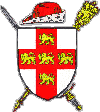


 |

|
 |
| "York is unusual among English cities for at least two reasons. First, the industrial revolution largely passed it by. York did not undergo the massive economic upheaval (population growth, re-building etc.) found in other English cities. Second, the predominant in-migrations in the 19th century were from local (Northeastern and Yorkshire) dialects…. For these reasons, York has retained a somewhat conservative character." (Tagliamonte, 1998: 158). |
Although these pages are devoted to York dialect, at the present time they cover only one aspect of dialect, i.e. grammar. All the information provided draws on the research of Dr Sali Tagliamonte of the University of York (Tagliamonte 1998; 2001; Tagliamonte and Lawrence, 2000). Her investigations are based on a large corpus of audiotape recordings of speakers born and raised in York. These speakers vary according to age, gender, education and occupations. All the citations and the majority of the examples provided in the following text are extracts from Tagliamonte's reports.
Because it has been necessary to employ a number of grammatical terms (shown in red when first mentioned), a glossary has been provided in each case via a pop-up message box. Access is achieved by pointing to the relevant item. An asterisk immediately preceding an example phrase or sentence indicates that the grammatical form is either unacceptable or ungrammatical.
In relation to the opening quote, the influx of a large population of Irish labourers during the development of the railways is not being ignored. Tagliamonte acknowledges their presence but, citing Finnegan (1982), points out that they were not absorbed into the local community and that, after a short period, they moved away.
She goes on to say that, since at least the early part of the 19th century, the speech of most of the inhabitants of York has embodied a fusion of dialects from 'a fairly circumscribed area of north Yorkshire'. Moreover, before the beginning of the 20th century, because York was passed over in relation to early accounts of regional English dialects, details of York English and that of the surrounding area are not well recorded (Tagliamonte, 1998).
In her research into York English, Tagliamonte has focussed on, inter alia:
It is however important to note that she is not claiming that all the features examined are peculiar solely to York English. Some characteristics are also attributes of other dialects. It should also be noted that the following pages provide only brief sample extracts of her work. Her published articles cover the above subjects in much greater depth and detail.
Note: Full copies of the relevant research material may be obtained by e-mailing Dr Tagliamonte at the University of York.
Sources and References
Finnegan, F.E. (1982) Poverty and Prejudice: A Study of Irish Immigrants in York, 1840-1875, Cork: Cork University Press,
Tagliamonte, S. (1998) Was / were variation across the generations: View from the city of York. Language Variation and Change, 10(2): 153-191, Cambridge University Press (Printed in USA).
Tagliamonte, S. and Lawrence, H. (2000) "I used to dance, but I don't dance now.": The Habitual Past in English. Journal of English Linguistics, 28(4): 323-353.
Tagliamonte, S. (2001) Come / came variation in English Dialects. American Speech, 76(1): 42-61.